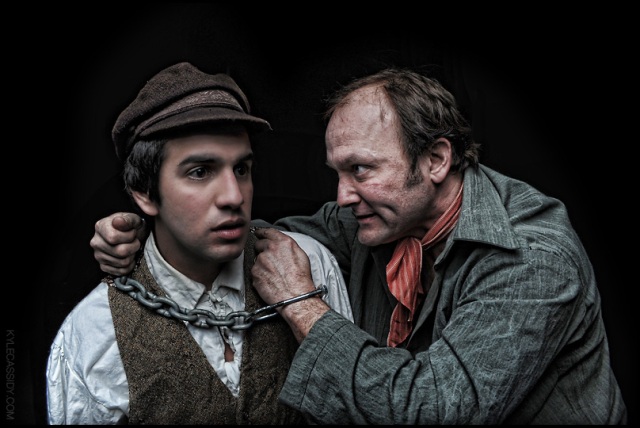Charles Dickens was a prolific writer, and both film and theatre companies have used his pieces as source material. Like several of his novels, Great Expectations was presented in serial form in the publication “All the Year Round” from December 1860 thru August 1861. Readers anxiously awaited month to month for the next installment of the story of an orphan boy named Pip. Filled with wonderful Dickensian characters, it has been adapted for stage and screen over 250 times. This latest version, now performing at Curio until March 5th, is the work of Artistic Associate and Company Member Jared Reed. He also serves as the production’s director, giving us a well-paced evening of great storytelling.

(l. to r.) Eric Scotolati portrays Pip and Paul Kuhn portrays Magwich in Curio Theatre Company’s production of GREAT EXPECTATIONS. (Photo credit: Kyle Cassidy)
The plot is a complex one that details Pip’s impoverished beginnings (being “raised by hand” by a cruel, domineering and much older sister, “Mrs. Joe”) and his attempts to become a gentleman thanks to the unexpected windfall from—and financial support of—an unknown benefactor. It spans 38 years from 1812 to 1840 as Pip’s fortunes rise and fall. The one constant throughout is his love for Estella, the adopted daughter of the eccentric recluse Miss Havisham—whom Pip and the reader are led to believe is Pip’s benefactor.
There are close to 40 characters in the novel, but Reed and his cast of six concentrate on those that drive the story forward. As is the case with many small theatre companies, Curio has limited resources. BUT—they use them well. Following the mantra of “keep-it-simple-stupid,” they have staged the piece minimally, using wooden benches, a table and a handful of props (in a bit of an homage to Our Town, most things are mimed). Yet the viewer very much feels as if he or she has been transported back to 19th century England.
This is due in large part to the wonderful characterizations of the ensemble of actors. All six serve as narrators, walking the audience through the many changes of locale and time; and 5 of them take on roughly 3 to 5 characters each to portray the various people who influence Pip’s life. Eric Scotolati plays Pip throughout the piece, never leaving the stage the entire 2 hours and 40 minutes. It is a wonderful performance; he easily transitions Pip from a naïve orphan boy of 7 to a man in his late 40s. He imbues the character with a lot of charm and shows us Pip’s genuine growth to a mature and caring man.
Swirling around him in a whirlwind of transformations are Liam Castellan (Compeyson, Jaggers, Orlick & Bentley Drummle), Aetna Gallagher (Mrs. Joe, Miss Havisham & Molly), Rachel Gluck (Estella, Biddy & Soldier), Paul Kuhn (Magwitch, Pumblechook & Wemmick) and Ken Opdenaker (Joe, Herbert, Mike, Aged Parent & Arthur). It was great fun to watch the nuances of each new characterization. Reed and his company have gone to great pains to make each one different, changing accents, vocal timbre and body language like you and I would change gloves. The physical ticks the actors gave to some of their characters were hilarious. So many times I have seen pieces where actors are essaying multiple roles, yet there is little differentiation between each one. It is wonderful fun to watch when talented performers are up to the challenge.
Adding to the whole feel was Drew Petersen’s excellent sound design; in addition to the many effects needed to create locale, etc., Petersen has composed some beautiful music to compliment the story. Andrew Cowles very skillfully surmounted the challenges of lighting a former church sanctuary to create a suitably 19th century ambiance—and with a limited number of instruments too. In addition to her acting duties, Ms. Gallagher costumed the piece. Each performer was given a basic ensemble of simple 1800s English country attire, to which they added assorted waistcoats, vests, shawls, etc. as they moved from one characterization to another. The two exceptions being Miss Havisham’s wedding dress (which was suitably rotted and eerie) and Estella’s morph from a young girl in a smock-type dress to an adult woman’s daydress. While the dialect work of Len Kelly was well done and the accents remained consistent throughout, a couple of the “country” dialects were a little muddled.
Paul Kuhn’s streamlined set design utilizes both a raised proscenium-like area and a parquet playing area on the floor; a sliding ramp and steps connect the two. Director Reed has created some very inventive staging, utilizing the space quite well. Since the audience is placed around the floor level area there are times when actors have their backs to you. This did create a challenge to hear some of the performers periodically, and on occasion they blocked one another. However, Reed seemed to navigate the issues of working in the round quite well for the most part.
Overall, I thoroughly enjoyed myself getting immersed in Dickens’ wonderful tale. This is a solid bit of ensemble work that is a pleasurable winter’s entertainment. I encourage you to check out Curio’s latest offering as soon as you can.
GREAT EXPECTATIONS
by Charles Dickens
Adapted and Directed by Jared Reed
February 3 – March 5, 2011
Curio Theatre Company
Calvary Center for Culture and Community
4740 Baltimore Avenue
Philadelphia PA 19143
215.525.1350
www.curiotheatre.org


